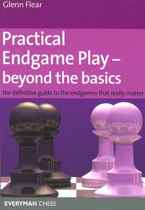Practical Endgame Play
Beyond the Basics
Glenn Flear
Reviewer: Jeremy Silman

Everyman Chess
2007
544 pages
paper
After writing my endgame book (which I stated was the first truly instructive endgame book), the other publishers quickly had their own endgame books written so they could get a piece of that particular “instructive endgame book pie. In Silmans Complete Endgame Course: From Beginner to Master, I mentioned that most players pick up the latest critically acclaimed endgame book, look it over for an hour or two, then put it on the shelf where it will never (or rarely) be looked at again. Why? Because the vast majority of endgame books are boring and dont supply guidance. In fact, much of the material in these books is way over the head of the average tournament player and, as a result, useless to them.
Oddly, the publishers and writers still rarely got it. Instead of heeding what the masses of chess hopefuls needed, they did what had always been done: create a huge book with tons of examples and little true instruction. They also added words to the front or back cover that would make one think that the book was suitable for everyone (“practical, “definitive, “essential, “fundamentals, etc.). And the question of the audience is of enormous importance a book can be very good, but also useless for all but the elite.
To its credit, Practical Endgame Play Beyond the Basics lets it be known right away that “basics have nothing to do with this book. Instead, we are given such heady material as Two Rooks vs. Rook and Minor Piece, Queen and Rook vs. Queen and Minor Piece, Rook vs. Two Minor Pieces, Queen vs. Rook and Bishop, Rook and Knight vs. Rook and Knight, and much more.
It must be said that grandmaster Flear covers this material extremely well. However, the front cover also tells us that this book is “the definitive guide to the endgames that really matter. Thus Im forced to ask, “Matter to whom?
The text is to the point but dry, many positions are far too complex for most players, and other positions just arent worth the little study time the vast majority of chess lovers have. IM John Donaldson is a big fan of this book, but even he wasnt sure about its proper audience. In the end, he decided that it would be best appreciated by players 2300 and above, and that sounds fairly accurate to me too.
And this takes us to the other endgame book well be looking at: Practical Endgame Play Mastering the Basics. Its clear that the publisher of both books, Everyman Chess, wanted to give a one-two endgame punch that covered the full range of playing levels. The Flear book is advanced, while the Grivas book covers basic stuff (the front cover says its, “the essential guide to endgame fundamentals). Of course, this begs a question: if the Flear book is the guide to endgames “that really matter, while the Grivas book covers other stuff, does that mean that the other stuff doesnt matter?
Seriously, the Grivas book makes a very good impression. It starts out by giving the “Golden Rules of the Endgame. And, it must be admitted that they are all quite useful! (I wont repeat them here buy the book if youre dying to find out what they are). He then moves on to a discussion about Opposition, then pawn endings (with key rules), corresponding squares (which I feel is more of a distraction to this audience than a help, but to each his own), triangulation, and much more. We also are given a lot of material on Rook endings, and a very full look at various minor piece endgames (Rook and Minor Piece Endings and Queen Endings follow).
Grivas gives us lots of explanatory prose, and he writes in a clear manner thats easy to follow. In fact, I like this book a lot!
Practical Endgame Play Mastering the Basics is an excellent purchase. If you are a fan of Mr. Grivas writing style, wish to add to the information I gave in Silmans Complete Endgame Course, or simply like really good endgame books, youll be happy with this one.
